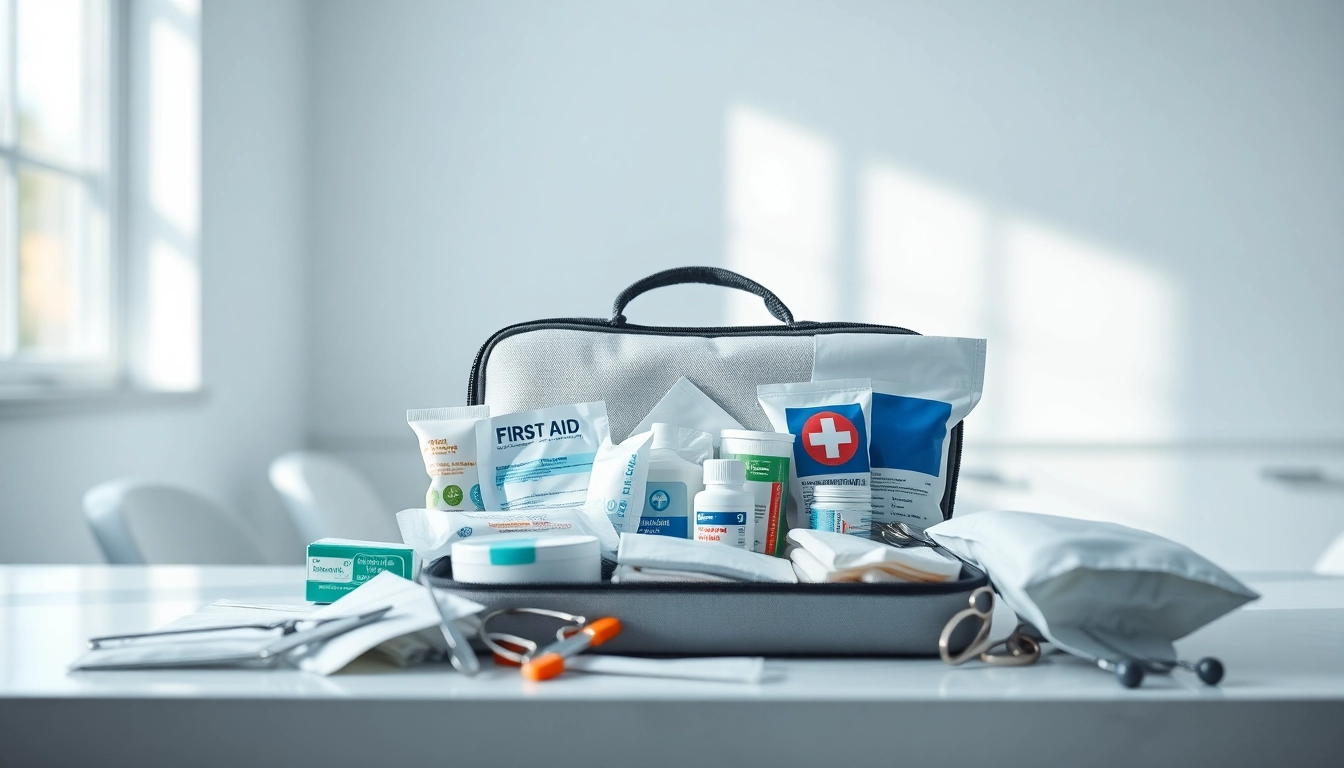
Essential Guide to First Aid: Techniques and Tools for Emergency Preparedness
Understanding First Aid: The Basics
What is First Aid?
First Aid refers to the initial care provided to a person who is injured or suddenly unwell, aimed at preserving life, preventing further harm, and promoting recovery. It encompasses a wide array of techniques and procedures that can be applied in critical situations, enabling a more favorable outcome for those affected. The essence of First Aid lies not just in treatment, but also in swift action and a clear understanding of what to do when emergencies arise. For those interested in learning more about the importance and techniques involved, First Aid education is a crucial step towards being better prepared for unforeseen circumstances.
Key Principles of First Aid
The fundamental principles of First Aid are crucial for effective intervention. These principles include the following:
- Preserve Life: The paramount aim of First Aid is to save lives. This includes assessing the scene to ensure safety for both the rescuer and the victim.
- Prevent Further Injury: It is essential to mitigate additional risks. This can mean moving an injured person only if necessary or immobilizing injuries to avoid exacerbating them.
- Promote Recovery: Facilitate a return to health through various measures, including comfort, assisting with necessary treatments, and encouraging proper professional medical care.
Understanding these principles lays the foundation for effective First Aid practice, making it easier to remember specific techniques when they are needed most.
Importance of First Aid Knowledge
Having knowledge about First Aid is vital for several reasons. Firstly, it empowers individuals to respond adeptly in emergencies, possibly saving lives. Statistics show that rapid response can significantly improve surviving rates in critical situations. Secondly, First Aid skills build confidence among individuals, fostering a sense of preparedness that can be applied in everyday life. Moreover, First Aid knowledge can be beneficial not only in personal scenarios but also in community settings, workplaces, and even public occasions. When more people are trained in First Aid, the overall safety and emergency response capacity of the community significantly improve.
Common First Aid Techniques You Should Know
CPR and Its Importance in Emergencies
Cardiopulmonary resuscitation (CPR) is a lifesaving technique that can be applied when someone is unresponsive and not breathing. CPR combines chest compressions with rescue breaths, aiming to maintain blood circulation and oxygenation until professional medical help arrives. Having the ability to perform CPR can make a critical difference, as brain damage can occur within minutes without oxygen. It’s essential for individuals to learn the steps of CPR: checking for responsiveness, calling for emergency help, and then starting chest compressions at an appropriate rate and depth. Regular training refreshers can also help maintain skills and confidence levels.
How to Treat Burns and Cuts
Burns and cuts are common injuries that require immediate attention to minimize damage and promote healing. For minor burns, the first step is to cool the burn with running water for at least ten minutes, which reduces inflammation and pain. Covering the area with a sterile dressing can prevent infection. For cuts, the focus is on stopping the bleeding, which can involve applying direct pressure. Sealing the wound afterward with a proper dressing is important to protect it from contaminants. Knowing how to effectively address these injuries can significantly impact recovery time and reduce complications.
Managing Sprains and Strains Effectively
Sprains and strains, often encountered in sports and daily activities, require immediate attention to manage pain and prevent further damage. The R.I.C.E. method—Rest, Ice, Compression, and Elevation—serves as a standard approach for treating these injuries. Resting the affected area prevents exacerbation, while ice helps to reduce swelling and pain. Compression involves wrapping the injured area with a suitable bandage to provide support, and elevation helps to reduce swelling. Prompt and effective management can accelerate recovery, allowing individuals to return to their normal routines.
First Aid Kits: Essential Items List
Must-Have Supplies for a First Aid Kit
Every household or workplace should have a well-stocked First Aid kit. Essential items to include are:
- Adhesive bandages in various sizes
- Sterile gauze pads and medical tape
- Antiseptic wipes and ointments
- Disposable gloves
- Scissors and tweezers
- Thermometer
- Pain relievers such as aspirin or ibuprofen
- A CPR face shield or mouthpiece
Having these supplies on hand enables prompt and effective treatment of everyday injuries and emergencies.
How to Customize Your First Aid Kit
While a basic First Aid kit is invaluable, customizing it according to individual and household needs can enhance its effectiveness. Consider the following factors when tailoring your kit:
- Medical History: Include any personal medications or supplies for chronic conditions, such as asthma inhalers or allergy medications.
- Age and Activities: Families with children may require items like children’s pain relievers or special dressings for common injuries associated with their activities.
- Prescription Medications: Having a backup supply of essential medications can be vital in emergencies.
Customizing your First Aid kit ensures that you are prepared for personal needs, maximizing the kit’s utility in emergencies.
Maintaining and Replenishing Your Kit
A well-stocked First Aid kit is only effective if it is regularly maintained. Friction and temperature fluctuations can affect supplies, and medications can expire. It’s vital to check your kit at least twice a year, replenishing any used items and replacing expired ones. Additionally, consider inspecting kits after any significant life events, such as vacations or outdoor adventures, when you may have used supplies or encountered new risks. Keeping your First Aid kit up-to-date fosters preparedness and confidence.
First Aid for Specific Situations
Dealing with Allergic Reactions
Allergic reactions can vary from mild to severe, with symptoms that may escalate quickly. Recognizing the signs—such as hives, swelling, difficulty breathing, or anaphylactic shock—is crucial for effective management. In cases of known severe allergies, having an epinephrine auto-injector available is essential. If an allergic reaction occurs, administering the auto-injector as directed, calling emergency services, and keeping the individual calm until help arrives are key steps in the response process. Education on recognizing and responding to allergic reactions can save lives.
What to Do in Case of Choking
Choking is a critical emergency that demands immediate attention. The Heimlich maneuver, or abdominal thrusts, is the primary technique used to dislodge an object blocking the airway. For adults and children over one year old, you need to stand behind the individual, place your arms around their waist, and apply upward thrusts. For infants, the approach involves alternating back blows and chest thrusts to dislodge the object. Understanding and practicing these techniques can empower individuals to react swiftly in choking situations and potentially save a life.
Handling Shock: Signs and Responses
Shock can occur as a result of a severe injury or sudden illness, affecting circulation and oxygen supply to vital organs. Common signs of shock include pale skin, rapid breathing, weakness, confusion, and a weak pulse. If shock is suspected, it is vital to lay the person down with their feet elevated, if no spinal injury is suspected. Keeping them warm with a blanket and ensuring they receive professional medical help is critical. Recognizing and responding to shock effectively can be a determining factor in a victim’s outcome and recovery.
Advancing Your First Aid Skills
First Aid Training and Certification Options
Engaging in formal First Aid training not only equips you with the necessary skills but also provides certification that can enhance your confidence and credibility. Many organizations offer courses ranging from basic First Aid to advanced First Responder training, often tailored for specific needs such as workplace safety or childcare. Completing a course and obtaining certification allows you to understand techniques in depth, practice them in a controlled environment, and recognize symptoms effectively, all of which prepare you for real-life situations.
Staying Updated on First Aid Practices
The world of First Aid is continually evolving, with new techniques, technologies, and guidelines being developed. As such, it is essential to stay informed about the latest practices. This can be achieved through regular re-certification, attending workshops, or engaging with reputable online platforms that offer updated information. Additionally, reading books from authoritative sources on First Aid can expand your perspective and understanding, allowing you to integrate new methods into your skillset effectively.
Resources and Tools for Continued Learning
Numerous resources are available for those who wish to enhance their First Aid knowledge and skills. Local community centers often host classes, while many health organizations provide online courses that can be accessed at your convenience. Books, webinars, and even mobile applications focusing on First Aid tips and guidelines can serve as valuable educational tools. All these resources contribute towards a continuous learning journey, ensuring that you remain proficient in the essential skills for providing effective First Aid.
